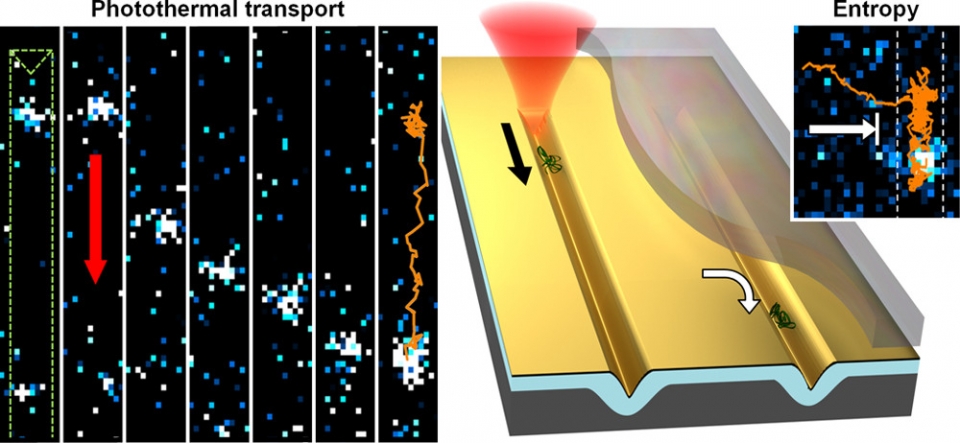
用光與熵放牧DNA
- Physics Today
- 撰文者:Katyayani Seal (譯者:林中一 教授)
- 發文日期:2017-07-25
- 點閱次數:637
在分析包括DNA在內的單個分子時,科學家需要使用流體的路徑來操控及輸送這些個體。他們使用「熵奈米侷限」技術,可以在流體管路內控制DNA與其他奈米尺寸的樣品的運動。科學家們也運用了在金屬中由光所激發的電子振盪所產生的電漿子來驅動這些分子的輸送;光引發的電漿子所產生的局域熱製造了熱梯度與流體運動將分子們向前推動。然而,要合併使用「熵奈米禁閉」與電漿子輸運一直是一個挑戰。「奈米禁閉」需要比目標分子迴旋半徑還要小的流體管道-對於許多DNA分子而言,這差不多是0.5微米-而運用電漿子流的輸運需用的管路高度卻要超過1微米。現在,丹麥技術大學的安德斯.克里斯坦森與他的同僚們已經成功的結合了這兩種技術。他們所示範的定向DNA輸送,打開了在現存微觀系統中對生物高聚物(biopolymer)光控操作的大門。

他們的方法是在奈米流體管路中埋置V-形的金屬溝槽,溝槽的錐形設計產生了多樣的長度尺度,使得那兩種機制可以同時進行:大的位能阱限制了分子的運動方向,而電漿子引發的熱梯度則引導了分子移動。
這個改良版的方法,以其驚人的可控性與靈活性,一方面避免了生物分子在管路中的堵塞與光致損壞,一方面也在管路中推動DNA分子。學者們現在準備使用他們的裝置去做DNA以及其他生物分子的特定點化學分析。

(From: http://pubs.acs.org/doi/abs/10.1021/acsnano.6b08563)
(原期刊論文參見:(C. L. C. Smith et al., ACS Nano 11, 4553, 2017, doi: 10.1021/acsnano.6b08563.)
本文感謝Physics Today (American Institute of Physics) 同意物理雙月刊進行中文翻譯並授權刊登。原文刊登並收錄於Physics Today, July/2017 雜誌內(Physics Today 70, 7, 25 (2017); doi: 10.1021/acsnano.6b08563);原文作者:Katyayani Seal。中文譯稿:林中一教授,國立中興大學物理系。
Physics Bimonthly (The Physics Society of Taiwan) appreciates that Physics Today (American Institute of Physics) authorizes Physics Bimonthly to translate and reprint in Mandarin. The article is contributed by Katyayani Seal and is published on Physics Today 70, 7, 25 (2017); doi: 10.1021/acsnano.6b08563). The article in Mandarin is translated by Prof. Chung-Yi Lin, working on Department of Physics, National Chung Hsing University.
http://physicstoday.scitation.org/doi/10.1063/PT.3.3620
本文感謝Physics Today (American Institute of Physics) 同意物理雙月刊進行中文翻譯並授權刊登。原文刊登並收錄於Physics Today, July/2017 雜誌內(Physics Today 70, 7, 25 (2017); doi: 10.1021/acsnano.6b08563);原文作者:Katyayani Seal。中文譯稿:林中一教授,國立中興大學物理系。
Physics Bimonthly (The Physics Society of Taiwan) appreciates that Physics Today (American Institute of Physics) authorizes Physics Bimonthly to translate and reprint in Mandarin. The article is contributed by Katyayani Seal and is published on Physics Today 70, 7, 25 (2017); doi: 10.1021/acsnano.6b08563). The article in Mandarin is translated by Prof. Chung-Yi Lin, working on Department of Physics, National Chung Hsing University.
http://physicstoday.scitation.org/doi/10.1063/PT.3.3620